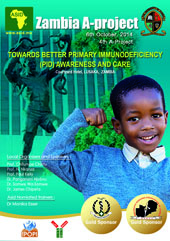Yousif Sulaiman, Idriss Matoug, Abdulla Alteer, Hanan Alsalheen, Salah Alamroni, Fatma Altajori.
Children's Hospital, Faculty of Medicine, Benghazi University, Benghazi, Libya.
Traduit par L Jeddane (Maroc)
La leishmaniose cutanéo-muqueuse est une des différentes formes de leishmainiose due à une infection parasitaire transmise par la morsure d’une mouche de sable. Elle est causée par L. braziliensis, L. panamensis et, moins fréquemment, L.amazonensis. L'infection est caractérisée par des lésions de la peau et des muqueuses de la bouche et du nez (1,2).
Dr I. Benhsaien
Clinical Immunology Unit, Hospital A. Harouchi, Casablanca, Morocco
Translated by L. Jeddane
Background: The Chediak-Higashi syndrome (CHS) is characterized by partial oculocutaneous albinism, immunodeficiency and bleeding tendency. These signs result from functional anomalies of polymorphonuclears containing characteristics large lysosomal inclusions and a functional defect of NK cells (Natural Killer). Transmission is autosomal recessive. CHS gene was localized on the long arm of chromosome 1, 1q42.1-q42.2. Once suspected, the diagnosis is based on the presence of granules in the white blood cells on the blood smear.
Dr I. Benhsaien
Unité d’Immunologie Clinique, Hôpital A. Harouchi, Casablanca, Maroc
Contexte : Le syndrome de Chediak-Higashi (CHS) est caractérisé par un albinisme oculocutané partiel, un déficit immunitaire et une tendance au saignement. Ces signes résultent d'anomalies fonctionnelles des polynucléaires contenant de grosses inclusions lysosomales caractéristiques et d'un déficit des lymphocytes NK (Natural Killer). La transmission est de type autosomique récessif. Le gène CHS a été localisé sur le bras long du chromosome 1, en 1q42.1-q42.2. Une fois suspecté, le diagnostic est basé sur la présence de granules dans les globules blancs sur le frottis sanguin.
Elfeky R1, Radwan N1, Hassanein SM2, Reda SM1
1 Paediatric Allergy and Clinical Immunology Unit,
2 Paediatric Neurology Unit, Children’s Hospital, Faculty of Medicine, Ain Shams university, Cairo, Egypt.
Background: Griscelli type 2 (GS2) is a rare disorder induced by mutations in RAB27A gene and characterized by oculocutaneous hypopigmentation and variable cellular immunodeficiency1. The Silvery gray hair with large, clumped melanosomes on microscopy of hairshafts are diagnostic. The commonest complication leading to mortality includes lymphohistiocytic proliferation in various organs, including the brain.2It is a fatal disease unless HSCT is commenced. Age at presentation and severity of disease varies within the same family members. Boys might have a severe disease than girls. IVIG might delay the development of HLH in GS2.



























